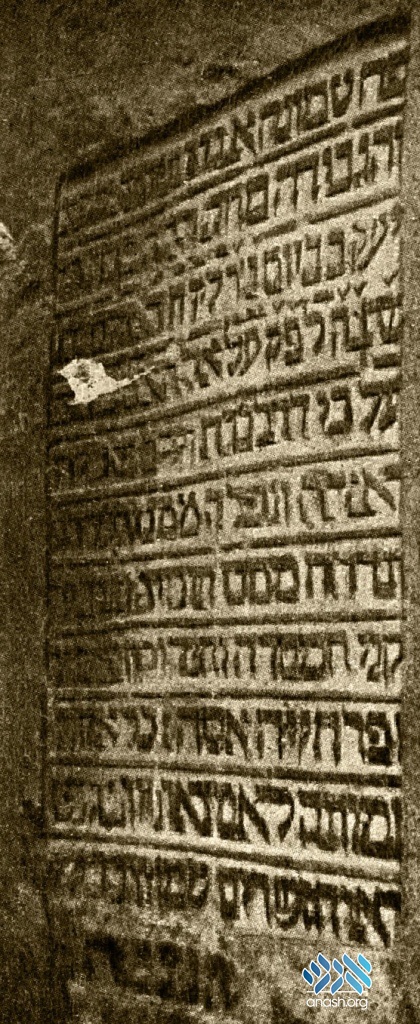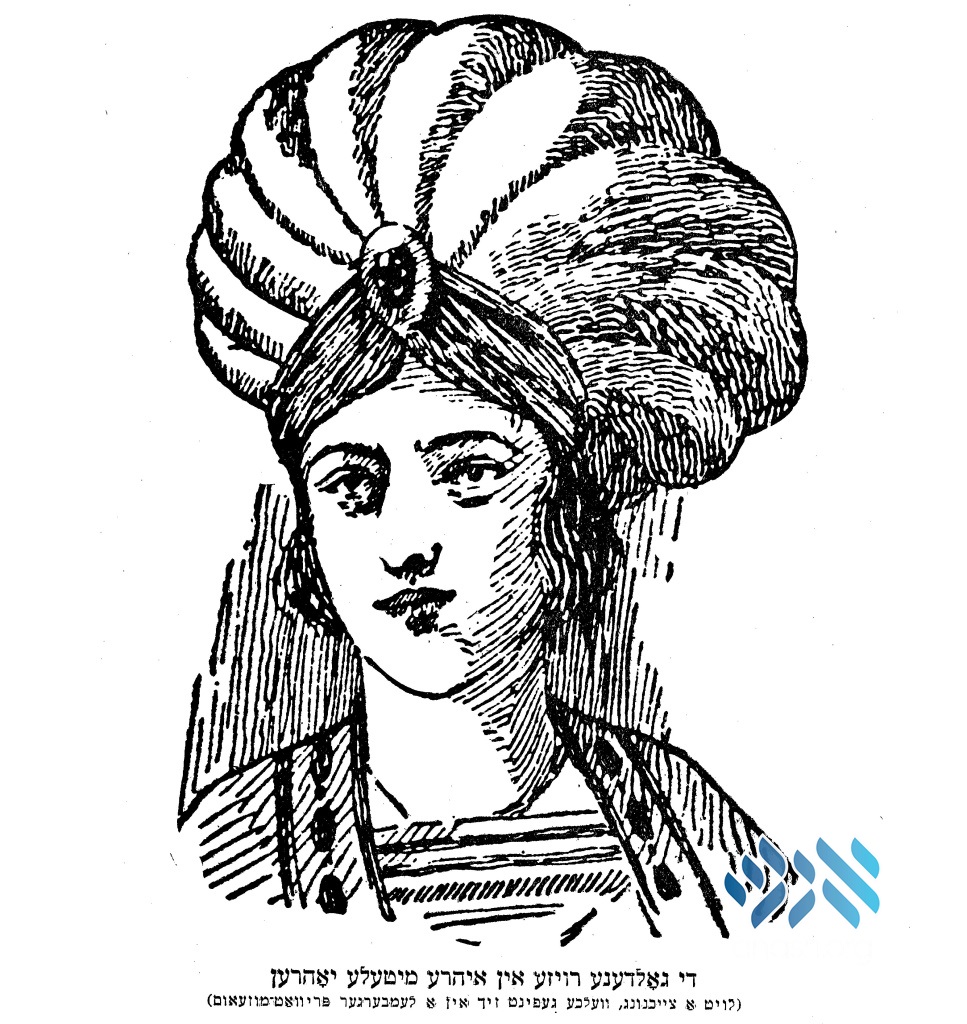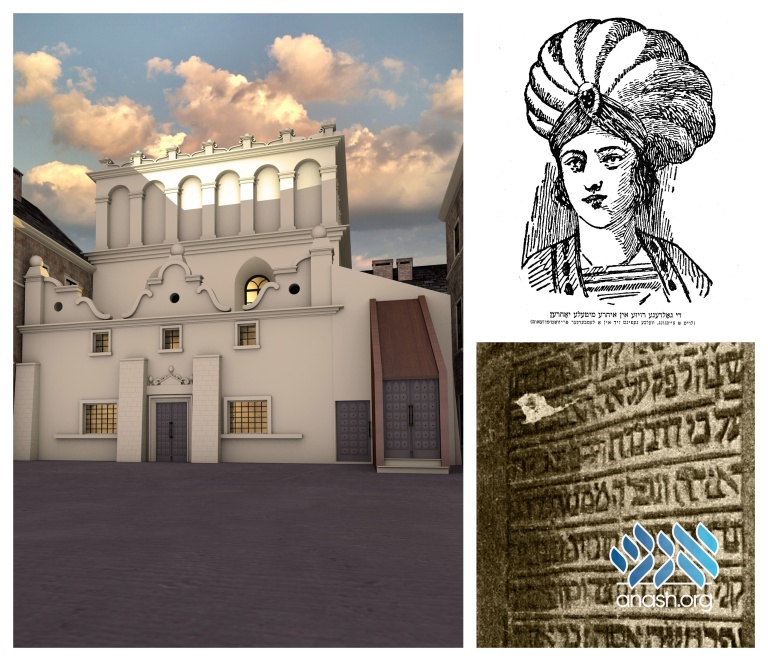כ״ח תשרי ה׳תש״פ | October 26, 2019
The Most Powerful Woman in Lemberg
“Golden Rose” was the name of an extraordinary woman who lived in Lemberg in the 1600’s. Kankan Journal explores her untold life story and the Gildne Royze Shul named after her.

By Yossi Kwadrat – Kankanjournal.com
Anash.org users can use code Anash19 and receive 5% off discount when they make a purchase from Kankan Publications.
A Rare Glimpse at an Extraordinary Woman
As we continue to investigate the mysterious chapters in our rich history, we begin to wonder why some of the most prominent figures and episodes, very dramatic and significant in their times, have become forgotten and virtually unknown today.
Once upon a time, these occasions were remembered by a designated date of celebration or mourning, like “Shabbos after Purim,” or by a new custom, for example, “saying Selichos in the midst of hakofos” or “a paroches on the aron kodesh.” Sometimes a mere headstone, as we will see soon, would suffice. But the miracles and happenings were always retold, passed on from generation to generation. Unfortunately, today nothing has remained. The memories and unique minhagim are forgotten, the special days are no longer, and many of the headstones have disappeared. One such incident very worth resurrecting from our long, forgotten history is an incident with a connection to the old shul in Lemberg.
The Lemberg Shul’s Name:
The Old Shul in Lviv (Lwów, also known as Lemberg, western Ukraine) was referred to by various names throughout its lifetime, until its destruction by the Ukranian Communists. The most known of these was “the Gildne Royze Shul.” This article is devoted to the Golden Rose, the special woman who is the shul’s namesake, but it is not clear to me why the shul carried her name.

An Interesting Episode:
The cemetery in Lemberg in the year 1919
It was not the norm for people to visit the bais hachaim unless one had yahrtzeit. This was due to the commonly-held fear of the mazikim, evil spirits that reside there. The cemeteries were not cared for properly and the grave stones were in bad shape. Today, the custom of going to kivrei tzaddikim has grown ever more popular, but in those days, even going to Lizhensk was unheard of until the Tiferes Shlomo made it a tradition. The kever of the Rema in Cracow was one exception to the rule, and many people would visit his kever on Lag Baomer, the day of his yarhtzeit.
In Lemberg there was another exception. However, in contrast to Cracow where it was only one day a year, crowds, mostly women, would come daily to pour their hearts out by this kever in Lemberg.
The kever as we know it replaced an older matzeivah that was worn and illegible, about 260 years old. It was near the kever of the Turei Zahav, the Chacham Tzvi, the holy Reitzes brothers, and the Yeshuos Yaakov in the secction reserved for prestigious rabbanim.
In Lemberg, a woman was experiencing a difficult labor and the mother and baby were in danger. The doctors had given up and the people of the city were saying Tehillim with great fervor. The women of the city ran to shul to pray and cry by the open aron kodesh, as was customary in those days during a time of need. Suddenly, a group of righteous women rushed into the room of the birthing mother with a long string and wrapped it around her. No sooner had they done this when sounds of “mazel tov” rang throughout the city and the news quickly spread that all was well with the mother and baby. This string that the women had brought in was from a string that had been wound around the headstone of the Golden Rose and was a segulah for difficult labors.
The Golden Rose was obviously not a simple woman, and we know of some families who are proud to be descendants of hers. Generally, yichus follows the line of the men in a family, and other than the holy Matriarchs, we don’t find many women who take a central place in their family’s lineage. However, this woman was an extraordinary one. One would assume that she was the wife or daughter of a great tzaddik, or that she spent all her days in prayer, or took kvitlach and recited Tikkun Chatzos. Yet she was the wife of a community leader (parnes) in Lemberg who did business, had a working relationship with government ministers, and even traveled to Cracow to do business with the royal house. In today’s world, the Golden Rose would be described as a business woman.
The Golden Rose is not mentioned in any Jewish texts, and there is very little information elsewhere about her. Amongst the inhabitants of Lemberg, for example, legend has it that when the Jesuits took over the shul in the beginning of the 17th century, the Golden Rose brought back the key of the shul at the expense of her life. But this tale is most likely an inaccurate portrayal of events because she lived a long and healthy life, as you will see in the coming chapters. Although some mention of her endeavors to assist the Jewish community was recorded in the annals of Lemberg history, only one thing has remained to bear witness to who she was, and that is a picture of the headstone that stood upon her gravesite. Here is the text of the epitaph on her headstone, followed by an explanation of its praises.

Copy Nusach of Matzeivah
Here lies a royal lady, a powerful noblewoman
Rosa, the daughter of R’ Yaakov;
buried on Tuesday, the fourth of Tishrei 5398 (1637).
I weep for you, for you brought bliss and joy in the house (daughter) of Jacob
Our crown has fallen and our salvation has been driven away.
And as the broken branches of the pure menorah, with its ornaments and flowers,
A woman among these I did not find.
Kings saw her, officers stood and bowed to her
May her soul be bound in the bond of eternal life.
In those days, inscriptions on matzeivos were not as long as there are today, and every word was weighed and measured. This is yet another way in which this matzeivah is an anomaly.
The day of her birth is not mentioned. Likewise, we have no information is provided about her father other than his name, R’ Yaakov. However, in various sources she is mentioned as the sister of the famous R’ Isaac R’ Yeckeles from Cracow. That would make her the niece of the Rema and the She’eiris Yosef. We will look into that possibility a little later on.
She was given the name Golden Roiza due to her golden heart. Based on the information we have from her matzeivah and the salvation people saw when davening at her kever, it seems that she was available to all broken hearts during her lifetime. She was busy with helping others and made time for everyone personally, even though her business and travel kept her fully occupied.
A royal lady, a powerful noblewoman:
It is known that the Golden Rose was the wife of the community leader, R’ Nachman Schrentzeles. He was the brother of the parnes R’ Mordechai Schrentzeles, and their father was R’ Isaac Schrentzeles who built the Lemberg shul. The Schrentzeles family, wealthy and aristocratic, dealt with all manners of important business. It is interesting that as long as R’ Nachman was alive there is no mention of his wife at all. Only after he passed away at a young age and she took over his business, including collecting taxes that came into the city of Lemberg, did her good name spread far and wide. This would explain why her husband’s name is absent from her headstone. He died twenty-seven years before her and by then she had built a name for herself as an independently worthy person even greater than her husband.
Kings saw her, officers stood and bowed to her
After R’ Nachman’s passing, the young Rose was left with small children at home, including an only son, Isaac, and she kept busy raising her family alone. At the same time, the responsibility of maintaining her husband’s business fell on her shoulders until her son was old enough to help out. Even though she had a golden heart, she put her benevolent nature aside and was not naive or fickle in her business dealings. Her brother-in-law, R’ Mordechai Schrentzeles, and a certain Avrohom Broda helped her find her footing in a world that was foreign to her until then, and they served as trustees for the inheritance of her orphans.
The first thing the Golden Rose did was to collect the money that the noble landowners (poritzim) owed her late husband. In Tishrei 1716, she called in an amount of 2,000 zlotys, owed to her by Aleksandra Zalewski. One month later she received the legal rights to all of Zalewski’s property. Two years later, she sued two people who owed her money, Iwana Rohatyńca and Anastazye Stefanowicz, and she received 800 florins. Later, she demanded that the noble Mikołaja Małyńskiego pay her back 400 zlotys he owed her, which he did. The same amount was remitted to her by Alberta Świrski that same year. These large sums were merely what was owed to her late husband, Nachman. Aside from this, she owned her own mill which brought in a large profit on a regular basis. She took nonsense from no one, and we find that she complained about one Matysa Fedorkowicz whom she suspected stole an old bottle of wine from her.
She quickly made a name for herself in business and she carried a lot of clout in the city. Due to her sharp business acumen coupled with all the tzedakah and good she did for others, the non-Jews, especially those in the government, had great respect for her. If she suspected someone of wrongdoing, they could be arrested and thrown into jail before they had a judge and jury.
After taking care of the debts owed to her late husband, she proceeded to rent the tax office in Lemberg. What does this mean? As mentioned earlier, the community in Lemberg was in the hands of the Schrentzeles family, R’ Isaac who built the shul and his two sons, R’ Mordechai and R’ Nachman, the husband of the Golden Roiza. In the years 1711-1720, there was also another family of parnasim, and one of them was R’ Yaakov Gombrycht.
R’ Gombrycht’s father was R’ Wolf from Lemberg. This R’ Wolf is an unknown figure, but his wife Hendel’s family is more familiar. She was a sister to Lemberg’s parnes, R’ Yisroel Aideles, who is recorded in the Lemberg archives as Israel Josefovicz, Yisroel, the son of Yosef. This R’ Yisroel was the father-in-law of the Lemberg Rosh HaYeshivah, the gaon R’ Yehoshua Falk, known as the Sema. This means that R’ Yaakov Gombrycht was an uncle to the Sema’s wife.
The Sema wanted to run a yeshivah rather than be busy as a rav. From remarks made in the forward to his sefer Meiras Enayim on Choshen Mishpat, we find telling information about his father-in-law, R’ Yisroel Aideles:
“Hashem, please listen to my prayer and put in the heart of my father-in-law, the giver and head of Lemberg and its suburbs, renowned everywhere, R’ Yisroel, the son of Yosef. He spoke to me and said, “A good deed came into my hands and I grasped it and stood by your side and granted you the worthy students that you sought.” I would say something and he granted it immediately. He built me a beautiful house of stone of many stories and my heart is full of joy.”
The Sema gave his sefer the name Meiras Einayim-Bais Yisroel to honor his father-in-law. The sefer is not referred to by both names, rather by the acronym Sema, which stands for Sefer Meiras Einayim. R’ Yisroel Aideles spent a lot of money for the sake of Torah.
Let us return to R’ Gombrycht, R’ Yisroel’s brother-in-law. The first time the name Gombrycht is mentioned in the Lemberg records is in reference to a contract signed between R’ Gombrycht, his partner, R’ Shaul Chaim’s of Yavoriv, and the Lemberg city council. They rented an estate, a building upon which there was an alcohol still and a honey factory with enough produce for three years.
The contract had thirty-six conditions of obligations, among them a stipulation that in trying times, the city council would try to make the terms easier for the partners. In the beginning, the business did not do well, and Gombrycht could not keep up with the payments. A plague had swept through the city making it impossible for employees to come to work. The city council, however, did not care about the circumstances; they ignored the contract and demanded the regular payments regardless.
R’ Gombrycht complained in court about the council, and the case was transferred to the royal court in Cracow. He was fortunate to receive an official letter of protection that deferred his debt and legal expenses for a year. As soon as R’ Gombrycht received his freedom from debt, he tried to rent a tax office from the city. There were booths at the entrances to the city, like tolls, where taxes were collected. He would have sole access to the collection of tax money. When the gentile nobles, eager to deprive their Jewish neighbors of a livelihood, found out about his plan, they demanded a larger sum so that the money wouldn’t go to R’ Gombrycht. They also attempted to take back control of the original estate that was providing him with funds. In the end, he lost the tax factory but retained the estate.
The Golden Roiza succeeded where R’ Gombrycht could not. She, although a Jewess, was an energetic, shrewd businesswoman who was highly respected. R’ Gombrycht had no prospects of obtaining rights to the tax office, but the gentiles caved when it came to the Golden Roiza. In the tax factory’s records, the Golden Rose is called “Infidelis Rosa Nachamnowa” – “the non-believer Roza, Nachmans’s wife.” (Any non-Christian was documented as such in the Polish records). In the city’s records which list the residents of the Jewish ghetto, she is mentioned with great respect as “Pania Roza” or “Madame Roza.”

Eventually, due to high taxation, the middle class began to avoid entering Lemberg. They stopped doing business there and the city lost the income from their taxes. Around the same time, a huge fire broke out in the Yaroslover market that destroyed all the stores, and along with that, a plague broke out. More and more people avoided Lemberg altogether, and no people means no taxes. The city council required the funds that taxes had brought in until that point and decided to circumvent the Golden Rose. They hired a tax collector of their own named Starosta Bonifosa Menishkov who took over the position of the Golden Rose.
In the year 1729, R’ Isaac Schrentzeles, the Golden Rose’s son, was already working with his mother at the tax factory. He was very aggressive in his collection of the taxes, even more so than his mother. If someone failed to pay, Isaac came with officers to demand the taxes.
Stanislov Masarki, a military captain from Cracow, did business in imported goods. He was exempt from taxation but R’ Yitzchok neglected to ask his mother whether or not Stanislov was required to pay. On Erev Shabbos Parshas Bo, R’ Yitzchok paid Stanislov a visit and took the taxes he thought were owed. Stanislav contacted the Golden Roiza who promptly paid him back the money.
Collecting taxes was not an easy job. A tax collector has many enemies and those unhappy people looked for ways and means to bury the Golden Rose. Then, that day arrived. In the year 1732, the Golden Rose received a parcel of land from Starosta Menishkov upon which she wanted to build several buildings. All the jealous gentiles, along with the city council who had no fond feelings for the Golden Rose, tried to prevent her from building on the land. The Golden Rose appealed to King Władysław IV Vasa. On Thursday, Parshas Naso, Sivan 2, the king ruled in favor of the Golden Rose and she was able to build on the land. Her name is recorded with great respect in the report of this ruling. The council, however, knew that Rose was old and weak by that point and they did not give up. The next time they complained, she didn’t appeal and the king stopped the construction until he would give his final decree. The end result is unknown because the Golden Rose met a tragic death in the interim.
Our crown has fallen from us and our assistance has been driven away. The branches of the menorah have been broken, with its ornaments and flowers.
We discussed that R’ Nachman, the husband of the Golden Rose, traveled to Warsaw to appeal to the Polish government about the shul. After his death, the Golden Rose took over his good work. Using her influence and her tact with diplomats, she worked incessantly for her brethren. Tuesday, Parshas Haazinu 1637, Tishrei 4, she went to visit an important official about a certain communal need. While in the home of gentile, she found herself in a compromising position and, horrified by the possibility of sin, she devised a plan to extricate herself.
The minister had stepped out to a side room when he heard a sudden thump from the next room. He ran back into the room where he had left the Golden Rose but saw nothing but an open window. He raced to the window and peered out, only to discover the Golden Rose lying lifeless on the ground below! The crown of Israel had fallen and the assistance to her brethren was no more. The flowers and ornaments in the phrase may be a reference to her fragile bones that were broken in her fall. She was buried near her husband, R’ Nachaman, and they shared a matzeivah, his on one side and hers on the other.
“It is for this reason we cry. The weeping and mourning was intensified in the House of Yaakov. It is no wonder that her tragic end was a source of mourning for her brethren, men and women alike. As it is known, “Bais Yaakov means the women.”
A woman like her is not found anywhere
This was not an exaggeration, as it is found in the words of Chazal, “The righteous are greater in their death than in their lives.” Her matzeivah became a propitious place to pray, as we mentioned above. There are many Roizas named for her, even among those who were not her descendants, and named so just because she was a great woman. She was truly one of a kind. In Lemberg, the name of the Golden Rose was never gone, it was often heard on the lips of the people until the great churban of Europe and many stories were told about her. She had much to do with the workings of the shul that her father-in-law built and therefore, the shul carried her name.
Such are the great ones of our nation, in every generation, both men and women alike. They give of themselves tirelessly for the benefit of Klal Yisroel while they are alive, and even by their deaths, they sanctify Hashem’s Name. May the Golden Rose continue to be a merit for her people!
Primary Sources: Professor Majer Bałaban, Izak Nachmanowicz żyd lwowski XVI, Lwów 1904; Żydzi Lwowscy, Lwów 1908; and Skizzen und Studien zur Geschichte der Juden in Polen, Berlin 1911.
Anash.org users can use code Anash19 and receive 5% off discount when they make a purchase from Kankan Publications.


Send us your feedback